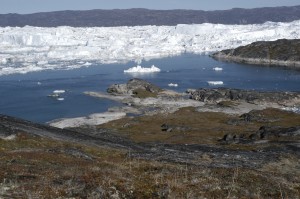
19th century CE. Ilulissat Icefjord, West Greenland. Photo by Claus Andreasen
Archaeologists have been arguing for decades about how human beings got to the new world, and genetic research released today deepens the mystery. An article published in “Science” magazine shows that there must have been at least four pulses of migration from Siberia through Alaska since the last Ice Age, and the Yupik and Inupiat people now in Alaska actually replaced an earlier population.
Based on the largest genetic sampling of bones found in the Arctic yet, a group of Danish researchers say the modern Native people of Arctic Canada and Alaska are only related in the very distant past to earlier waves that came across thousands of years ago. In fact, says lead author Maanasa Ragavan, the earlier arctic population – known in Siberia as “Saqqaq,” and on this side as “Paleo-Eskimo” and “Dorset,” was here for thousands of years, and was also genetically distinct from the earlier migrations that resulted in the Athabascan and other American Indian populations.
“We propose that we remove the Paleo Eskimos from that particular migration wave, and basically grant them a separate migration pulse of their own, which is the Paleo Eskimos, including the Saqqaq and Pre-Dorset culture and the Dorset culture,” Ragavan says.
Dr. Eska Willerslev, who heads the genetic lab, is flatly amazed that the people along the arctic coast and those on the interior of the continent literally had nothing to do with one another, even though their geography overlapped.
“I was actually surprised that we don’t find any evidence of admixture between Native Americans and Paleo Eskimos,” Willerslev says. “I mean, given that in other studies when we see people meeting each other, they may be fighting each other but normally they actually also have sex with each other, and that doesn’t seem to have been the case here.”
The picture that emerges is of a people now vanished, who developed a stable culture that lived off the lean country of the Arctic for at least four thousand years. Archaeologist William Fitzhugh of the Smithsonian Institution theorizes that they could only have done that by being very conservative:
“When you have people that are so close to nature as the Paleo Eskimos had to be to survive, they had to be extremely careful about maintaining good relationships with the animals, and that meant not in a sense polluting your relationship by introducing new ideas, new rituals, new materials and so forth,” Fitzhugh explains.
Then about 700 years ago, a new wave out of Alaska and Siberia known as the “Thule” people simply replaced them. The genetic evidence shows there was very little interbreeding, and the Thule people, from whom the modern Inuit population is descended, replaced the conservative Dorset.
“Socially and economically, they just were no match for this onslaught from this Thule machine that moved in in very quick order.”
Fitzhugh says the Thule migration, equipped with sled dogs, bows and arrows, and a near military whaling discipline, only took about a hundred years to sweep all across the upper part of the continent, and that was the end of the Dorsets.
“They were in a sense sitting ducks. And either they were pushed out into the fringes of the arctic area where they couldn’t survive economically or else they may simply have been annihilated,” Fitzhugh says.
It was thought there was a remnant Dorset population in a remote part of Canada, but the genetics show that not to be the case. They are gone. Fitzhugh says archaeologists need to dig more in Alaska and Siberia to puzzle out these migrations.
The genetics indicate they are likely to have come from the same area – an environment somewhere in the Russian far east so severe as to have almost fossilized the culture:
“And it may be that this is a continuation of a Siberian Mesolithic, Neolithic tradition which has just somehow kept on going in the eastern arctic because of the isolation and the abundance of animals that kept them without annihilating them through some sort of huge climatic changes or other things. It’s really an amazing story of continuity and survival.”
Willerslev says from a scientific point of view they could really use more archaeological genetic data from lower latitudes but that can be hard to come by because it is often the wish of modern tribes that ancient remains not be disturbed.
sheimel (at) alaskapublic (dot) org | 907.550.8454 | About Steve




